Historic Houses
In and Around Enumclaw
In and Around Enumclaw
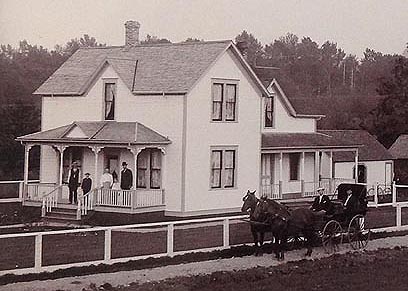
NOTES
1. Nancy Irene Hall. In the Shadow of the Mountain. The Courier Publishing, Enumclaw, 1983, and republished by Heritage Quest Press, Orting, 2004. p. 70.
2. Mrs. Gardner Reynolds. Pioneer History of Enumclaw. Enumclaw Women's Progressive Club, 1938. p. 73. (Mrs. Reynolds bought 160 acres and lived there with her two little girls.)
RESOURCES
1. "The City of Enumclaw". Historic Walking Tour Series. The Communities of the Carbon and White River Valleys.
This pamphlet is a map and walking tour guide to 21 historic houses and 13 commercial buildings in Enumclaw. Each description includes the date built and information about the original owners.
2. King County Parcel Viewer. Drag the map up to that Enumclaw appears in the center. Use the zoom to bring the town in closer. As you zoom in, drag the map to keep the street or property you are searching for centered. When you find the parcel you want, click on it. A pop-up will appear with basic information. Click on "Property Report" to get more, including the year the house was built.
A note about dates on house picture captions: County records, at least on Parcel Viewer, show the date a house was built in the Property Report. However, any date for 1900 or before is listed as 1900.
1. Nancy Irene Hall. In the Shadow of the Mountain. The Courier Publishing, Enumclaw, 1983, and republished by Heritage Quest Press, Orting, 2004. p. 70.
2. Mrs. Gardner Reynolds. Pioneer History of Enumclaw. Enumclaw Women's Progressive Club, 1938. p. 73. (Mrs. Reynolds bought 160 acres and lived there with her two little girls.)
RESOURCES
1. "The City of Enumclaw". Historic Walking Tour Series. The Communities of the Carbon and White River Valleys.
This pamphlet is a map and walking tour guide to 21 historic houses and 13 commercial buildings in Enumclaw. Each description includes the date built and information about the original owners.
2. King County Parcel Viewer. Drag the map up to that Enumclaw appears in the center. Use the zoom to bring the town in closer. As you zoom in, drag the map to keep the street or property you are searching for centered. When you find the parcel you want, click on it. A pop-up will appear with basic information. Click on "Property Report" to get more, including the year the house was built.
A note about dates on house picture captions: County records, at least on Parcel Viewer, show the date a house was built in the Property Report. However, any date for 1900 or before is listed as 1900.
Resources
About
Contact
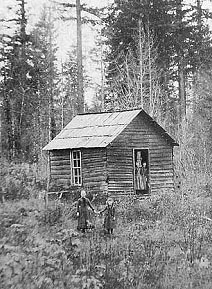
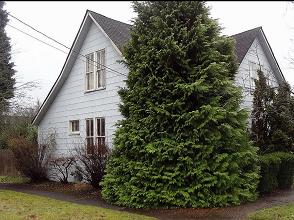
A draw to the Enumclaw area from its earliest days was an opportunity to have a house, whether it be on a homestead, in a small town, or part of a suburban development. As you walk or drive around Enumclaw, you can see the domestic spectrum in terms of age, size, and setting. Try to imagine the dreams of those who first occupied each of these homes.
A hand-split cedar shack was the common first step for the earliest newcomers, regardless of their past or future station in life. That included the Stevensons, pioneers of the town; the Hansons, founders of the White River Lumber Company; and many struggling settlers who abandoned their claims and disappeared. (1) These early first houses, meant to be interim housing, remain only in pictures.
The handsplit cedar cabin of the Hansens, who later owned the White River Lumber Company.
Mrs. Gardner Reynolds described her family's arrival and first house in Enumclaw. "We moved into an old shack back in the woods. There was one room with no windows or doors. The Stevensons had just moved into their hotel and it was the shack they had lived in that we now occupied. . . We lived in this place until we could build us a house on the ranch. Perhaps it was six weeks. . . In those days a house was built very quickly, two rooms, boarded up and down and battened, floor laid, windows and doors in and it was a house. No chimney was made, only a stove pipe." (2)
The shacks were replaced at the earliest opportunity with bigger and sometimes also temporary shelter. But with a ready supply of lumber, substantial farm and town houses soon appeared and many of these artifacts of the time remain today.
Frank Stevenson, immigrant and coal miner, homesteaded on 160 acres of what is today the center of Enumclaw. In the first years, he and Mary farmed, but the coming of the railroad opened new opportunities. They platted the town and became prosperous by selling lots. As businesses succeeded, their owners often subdivided their properties into additions such as Blake's, Reber's, and Jensen's, reaching into adjacent farms. Neighborhoods started taking shape.
The shacks were replaced at the earliest opportunity with bigger and sometimes also temporary shelter. But with a ready supply of lumber, substantial farm and town houses soon appeared and many of these artifacts of the time remain today.
Frank Stevenson, immigrant and coal miner, homesteaded on 160 acres of what is today the center of Enumclaw. In the first years, he and Mary farmed, but the coming of the railroad opened new opportunities. They platted the town and became prosperous by selling lots. As businesses succeeded, their owners often subdivided their properties into additions such as Blake's, Reber's, and Jensen's, reaching into adjacent farms. Neighborhoods started taking shape.
Many of the most prominent townspeople built large houses up on the "hill", an overstatement about the slight rise west of Porter Street. Here you can still see the homes of the Jensens, Blakes, Smiths, Montgomerys, Inglises, Bowlers, Stones, Ulmans, Olsons, and several members of the Hanson family. Although these houses each had a different design, many shared a common feature now gone--a white rail perimeter fence to keep out the wandering pigs and cows.Many of the most prominent townspeople built large houses up on the "hill", an overstatement about the slight rise west of Porter Street. Here you can still see the homes of the Jensens, Blakes, Smiths, Montgomerys, Inglises, Bowlers, Stones, Ulmans, Olsons, and several members of the Hanson family. Although these houses each had a different design, many shared a common feature now gone--a white rail perimeter fence to keep out the wandering pigs and cows.
The Bowler house, built in 1888 and located at 1637 Marion, is the oldest house still standing in Enumclaw.
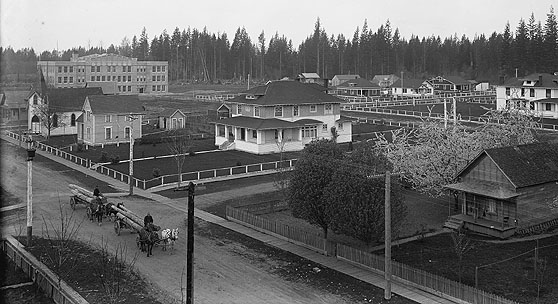
Fences to keep out the wandering pigs and cows
Lou Olson house on Griffin in center
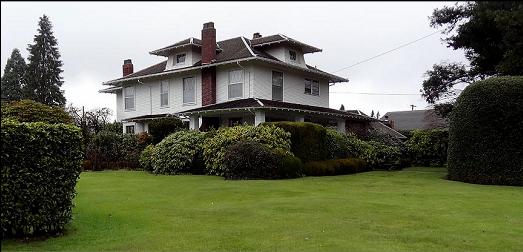
Window and trim detail was unique to the time, and not just in the large houses. Frames were constructed in a variety of shapes and arranged in unusual patterns, while intricate artistry in wood decorated many of the eaves. Roofs took on much more than a functional role as defining features of the houses.
J. J. Smith house, built in 1904 at 1718 Marion Street
Erickson house
Usually complementing the roofs were fancy front porches. People walked the neighborhoods and used the porches for sitting and chatting with (or impressing) strolling friends. In future generations, leisure life shifted from the community-focused front of the house to the private fenced backyard. Front porches were eliminated for many decades, but have reappeared in the past twenty years or so. However, they are now primarily decorative since the migration to the backyard never reversed.
Of course, not all the interesting houses were in town, and many of the old farmhouses still serve families well. They were not unlike most of the city houses, with interesting windows, dormers, trim, and porches. Some were torn down, but many have been retained, even with modern replacements standing beside them.
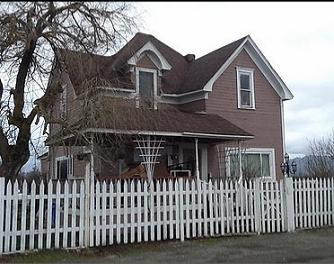
1905 farmhouse at 25310 SE 464th Street
There are many interesting old houses in the area; the pictures and descriptions are just a sampling. I will be including more as I discover them. Feel free to send your own pictures and comment about your house or others.
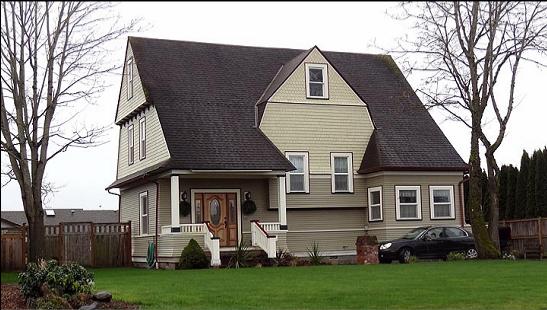
The old Borgaard house was moved from 448 Roosevelt Avenue (highway 410) to 2840 Christianson Street.